Exploring Mental Health Barriers in UK's BAME Youth (16-25)
VerifiedAdded on 2020/10/22
|35
|13772
|139
Essay
AI Summary
This dissertation examines the barriers to mental health help-seeking faced by young Black, Asian, and Minority Ethnic (BAME) individuals aged 16-25 in the UK. The study investigates the prevalence of mental health issues within this demographic, explores associated risk factors, and identifies significant obstacles to accessing mental health services. It critically evaluates existing mental health policies and practices relevant to the BAME community, comparing and contrasting findings from various studies to identify consistencies and inconsistencies. The research delves into the impact of methodological approaches on the findings, aiming to provide recommendations for improving mental health support and reducing disparities in access to care for this vulnerable population. The assignment covers project background, rationale, aims, objectives, methodology, literature review, findings, discussion, conclusions, and recommendations, offering a comprehensive analysis of the challenges faced by young BAME individuals in navigating the mental healthcare system in the UK.
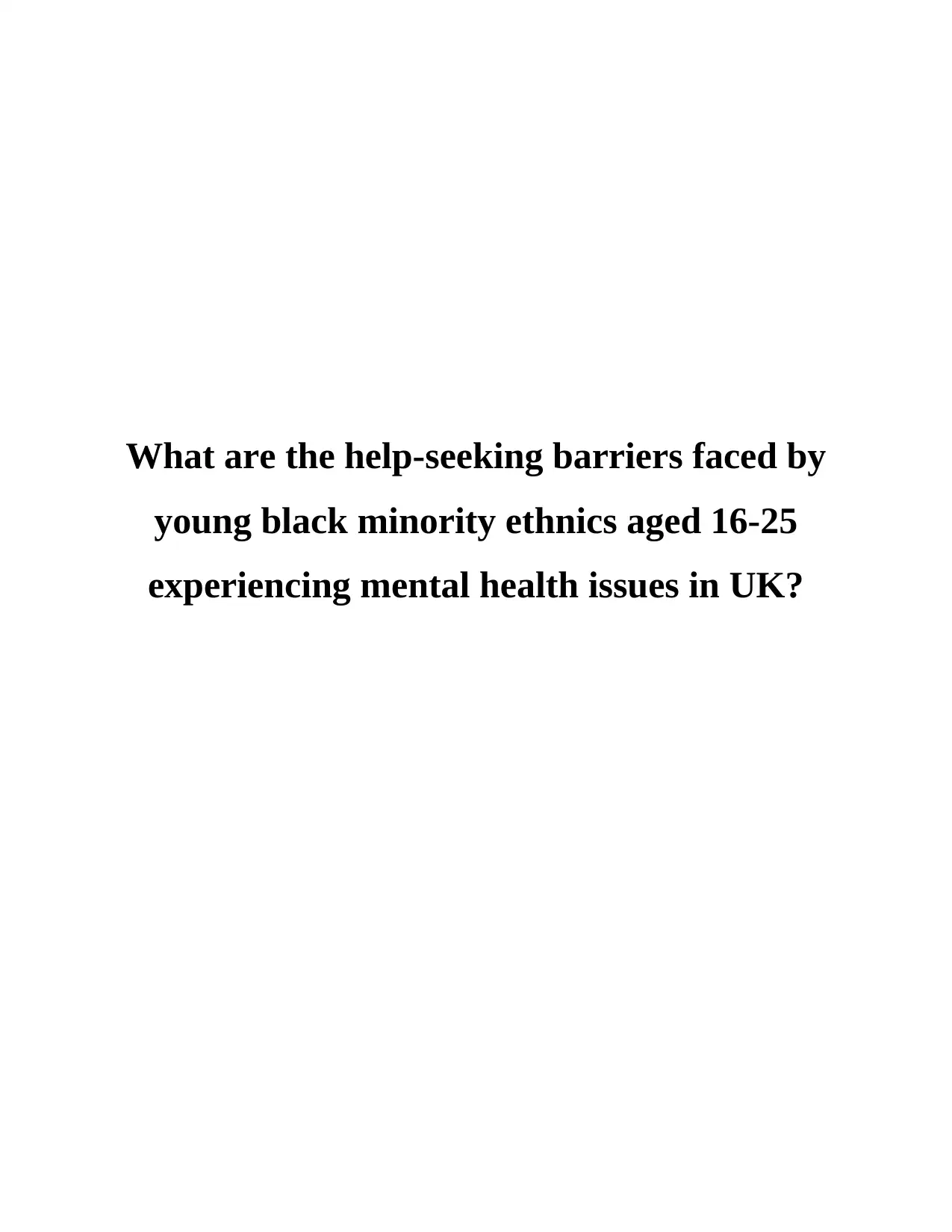
What are the help-seeking barriers faced by
young black minority ethnics aged 16-25
experiencing mental health issues in UK?
young black minority ethnics aged 16-25
experiencing mental health issues in UK?
Paraphrase This Document
Need a fresh take? Get an instant paraphrase of this document with our AI Paraphraser
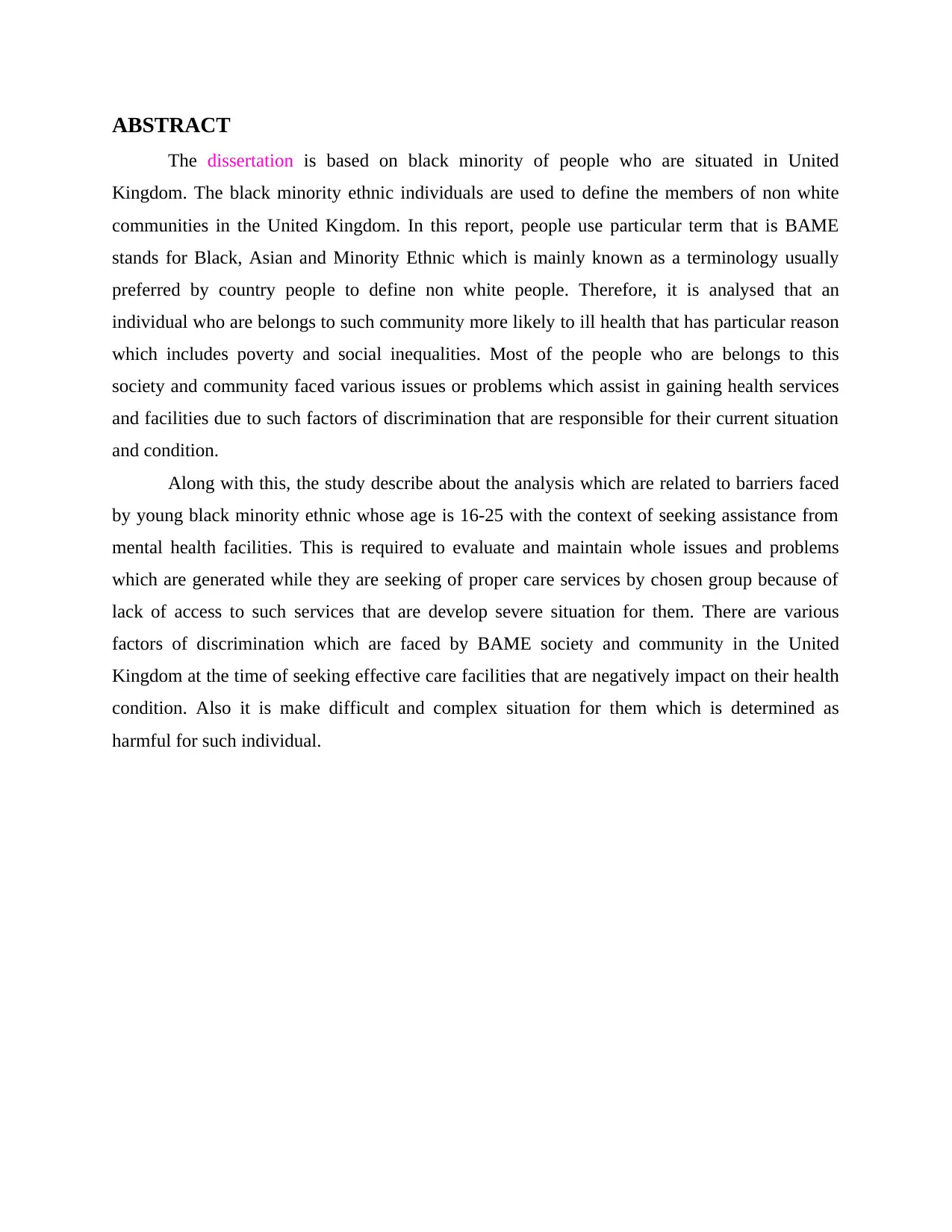
ABSTRACT
The dissertation is based on black minority of people who are situated in United
Kingdom. The black minority ethnic individuals are used to define the members of non white
communities in the United Kingdom. In this report, people use particular term that is BAME
stands for Black, Asian and Minority Ethnic which is mainly known as a terminology usually
preferred by country people to define non white people. Therefore, it is analysed that an
individual who are belongs to such community more likely to ill health that has particular reason
which includes poverty and social inequalities. Most of the people who are belongs to this
society and community faced various issues or problems which assist in gaining health services
and facilities due to such factors of discrimination that are responsible for their current situation
and condition.
Along with this, the study describe about the analysis which are related to barriers faced
by young black minority ethnic whose age is 16-25 with the context of seeking assistance from
mental health facilities. This is required to evaluate and maintain whole issues and problems
which are generated while they are seeking of proper care services by chosen group because of
lack of access to such services that are develop severe situation for them. There are various
factors of discrimination which are faced by BAME society and community in the United
Kingdom at the time of seeking effective care facilities that are negatively impact on their health
condition. Also it is make difficult and complex situation for them which is determined as
harmful for such individual.
The dissertation is based on black minority of people who are situated in United
Kingdom. The black minority ethnic individuals are used to define the members of non white
communities in the United Kingdom. In this report, people use particular term that is BAME
stands for Black, Asian and Minority Ethnic which is mainly known as a terminology usually
preferred by country people to define non white people. Therefore, it is analysed that an
individual who are belongs to such community more likely to ill health that has particular reason
which includes poverty and social inequalities. Most of the people who are belongs to this
society and community faced various issues or problems which assist in gaining health services
and facilities due to such factors of discrimination that are responsible for their current situation
and condition.
Along with this, the study describe about the analysis which are related to barriers faced
by young black minority ethnic whose age is 16-25 with the context of seeking assistance from
mental health facilities. This is required to evaluate and maintain whole issues and problems
which are generated while they are seeking of proper care services by chosen group because of
lack of access to such services that are develop severe situation for them. There are various
factors of discrimination which are faced by BAME society and community in the United
Kingdom at the time of seeking effective care facilities that are negatively impact on their health
condition. Also it is make difficult and complex situation for them which is determined as
harmful for such individual.
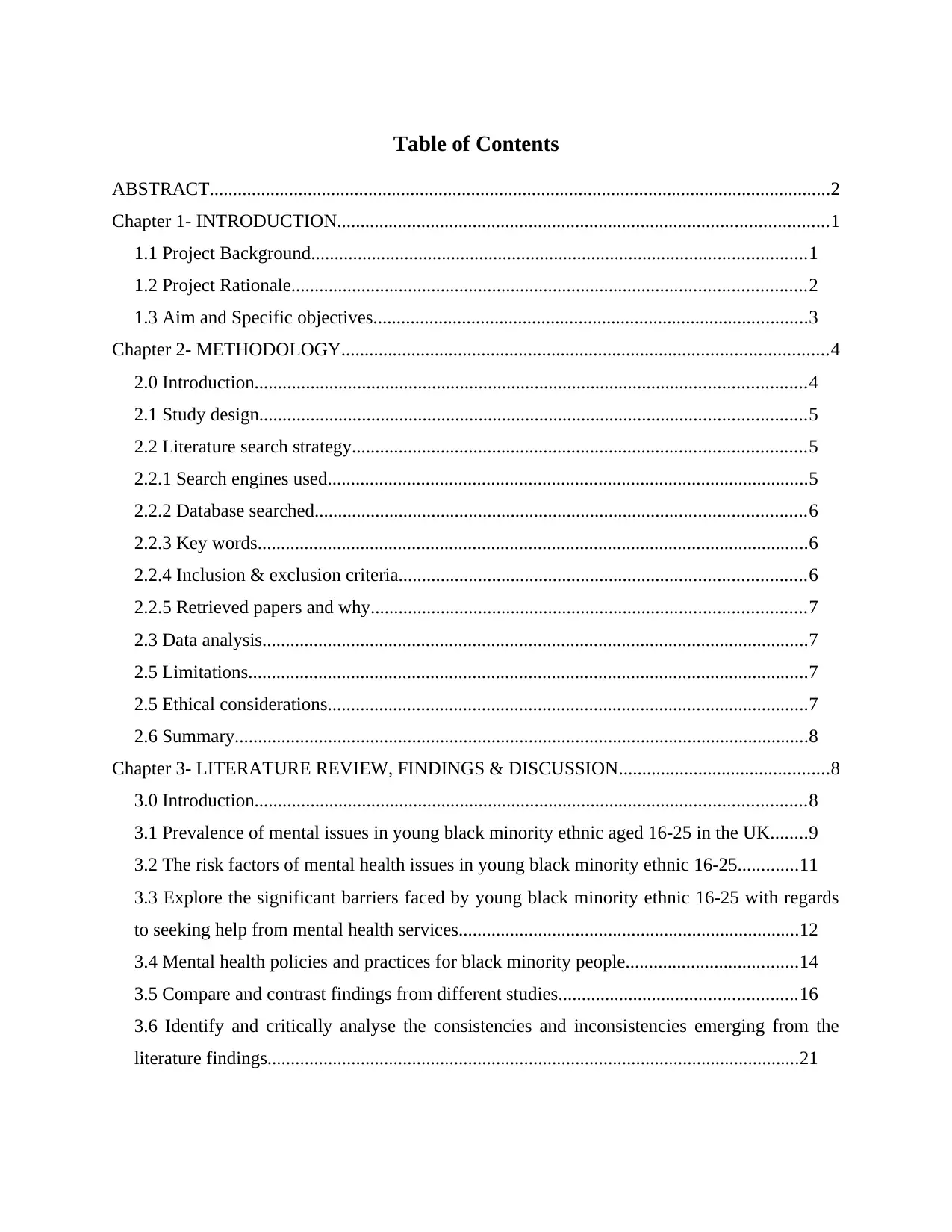
Table of Contents
ABSTRACT.....................................................................................................................................2
Chapter 1- INTRODUCTION.........................................................................................................1
1.1 Project Background..........................................................................................................1
1.2 Project Rationale..............................................................................................................2
1.3 Aim and Specific objectives.............................................................................................3
Chapter 2- METHODOLOGY........................................................................................................4
2.0 Introduction......................................................................................................................4
2.1 Study design.....................................................................................................................5
2.2 Literature search strategy.................................................................................................5
2.2.1 Search engines used.......................................................................................................5
2.2.2 Database searched.........................................................................................................6
2.2.3 Key words......................................................................................................................6
2.2.4 Inclusion & exclusion criteria.......................................................................................6
2.2.5 Retrieved papers and why.............................................................................................7
2.3 Data analysis.....................................................................................................................7
2.5 Limitations........................................................................................................................7
2.5 Ethical considerations.......................................................................................................7
2.6 Summary...........................................................................................................................8
Chapter 3- LITERATURE REVIEW, FINDINGS & DISCUSSION.............................................8
3.0 Introduction......................................................................................................................8
3.1 Prevalence of mental issues in young black minority ethnic aged 16-25 in the UK........9
3.2 The risk factors of mental health issues in young black minority ethnic 16-25.............11
3.3 Explore the significant barriers faced by young black minority ethnic 16-25 with regards
to seeking help from mental health services.........................................................................12
3.4 Mental health policies and practices for black minority people.....................................14
3.5 Compare and contrast findings from different studies...................................................16
3.6 Identify and critically analyse the consistencies and inconsistencies emerging from the
literature findings..................................................................................................................21
ABSTRACT.....................................................................................................................................2
Chapter 1- INTRODUCTION.........................................................................................................1
1.1 Project Background..........................................................................................................1
1.2 Project Rationale..............................................................................................................2
1.3 Aim and Specific objectives.............................................................................................3
Chapter 2- METHODOLOGY........................................................................................................4
2.0 Introduction......................................................................................................................4
2.1 Study design.....................................................................................................................5
2.2 Literature search strategy.................................................................................................5
2.2.1 Search engines used.......................................................................................................5
2.2.2 Database searched.........................................................................................................6
2.2.3 Key words......................................................................................................................6
2.2.4 Inclusion & exclusion criteria.......................................................................................6
2.2.5 Retrieved papers and why.............................................................................................7
2.3 Data analysis.....................................................................................................................7
2.5 Limitations........................................................................................................................7
2.5 Ethical considerations.......................................................................................................7
2.6 Summary...........................................................................................................................8
Chapter 3- LITERATURE REVIEW, FINDINGS & DISCUSSION.............................................8
3.0 Introduction......................................................................................................................8
3.1 Prevalence of mental issues in young black minority ethnic aged 16-25 in the UK........9
3.2 The risk factors of mental health issues in young black minority ethnic 16-25.............11
3.3 Explore the significant barriers faced by young black minority ethnic 16-25 with regards
to seeking help from mental health services.........................................................................12
3.4 Mental health policies and practices for black minority people.....................................14
3.5 Compare and contrast findings from different studies...................................................16
3.6 Identify and critically analyse the consistencies and inconsistencies emerging from the
literature findings..................................................................................................................21
⊘ This is a preview!⊘
Do you want full access?
Subscribe today to unlock all pages.

Trusted by 1+ million students worldwide
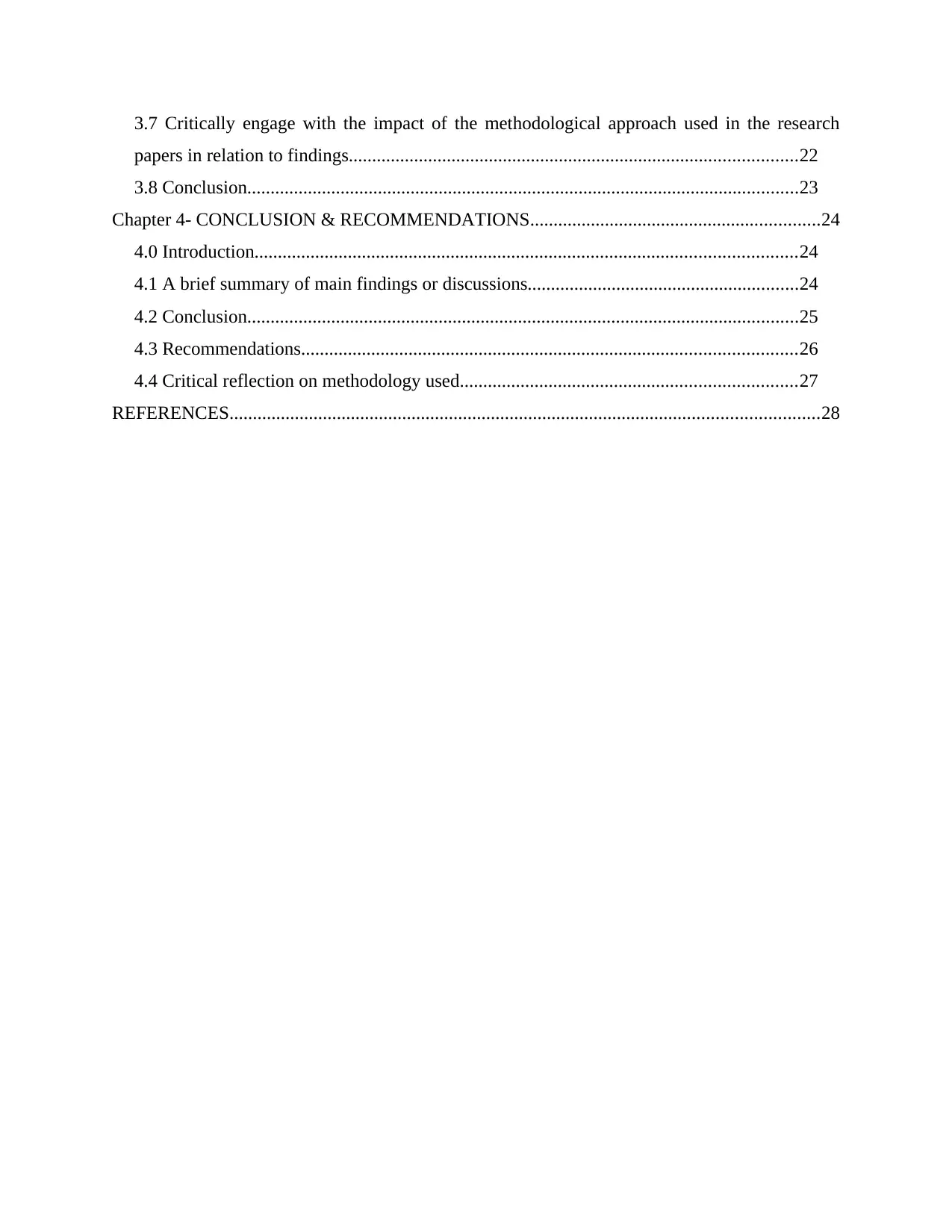
3.7 Critically engage with the impact of the methodological approach used in the research
papers in relation to findings................................................................................................22
3.8 Conclusion......................................................................................................................23
Chapter 4- CONCLUSION & RECOMMENDATIONS..............................................................24
4.0 Introduction....................................................................................................................24
4.1 A brief summary of main findings or discussions..........................................................24
4.2 Conclusion......................................................................................................................25
4.3 Recommendations..........................................................................................................26
4.4 Critical reflection on methodology used........................................................................27
REFERENCES..............................................................................................................................28
papers in relation to findings................................................................................................22
3.8 Conclusion......................................................................................................................23
Chapter 4- CONCLUSION & RECOMMENDATIONS..............................................................24
4.0 Introduction....................................................................................................................24
4.1 A brief summary of main findings or discussions..........................................................24
4.2 Conclusion......................................................................................................................25
4.3 Recommendations..........................................................................................................26
4.4 Critical reflection on methodology used........................................................................27
REFERENCES..............................................................................................................................28
Paraphrase This Document
Need a fresh take? Get an instant paraphrase of this document with our AI Paraphraser

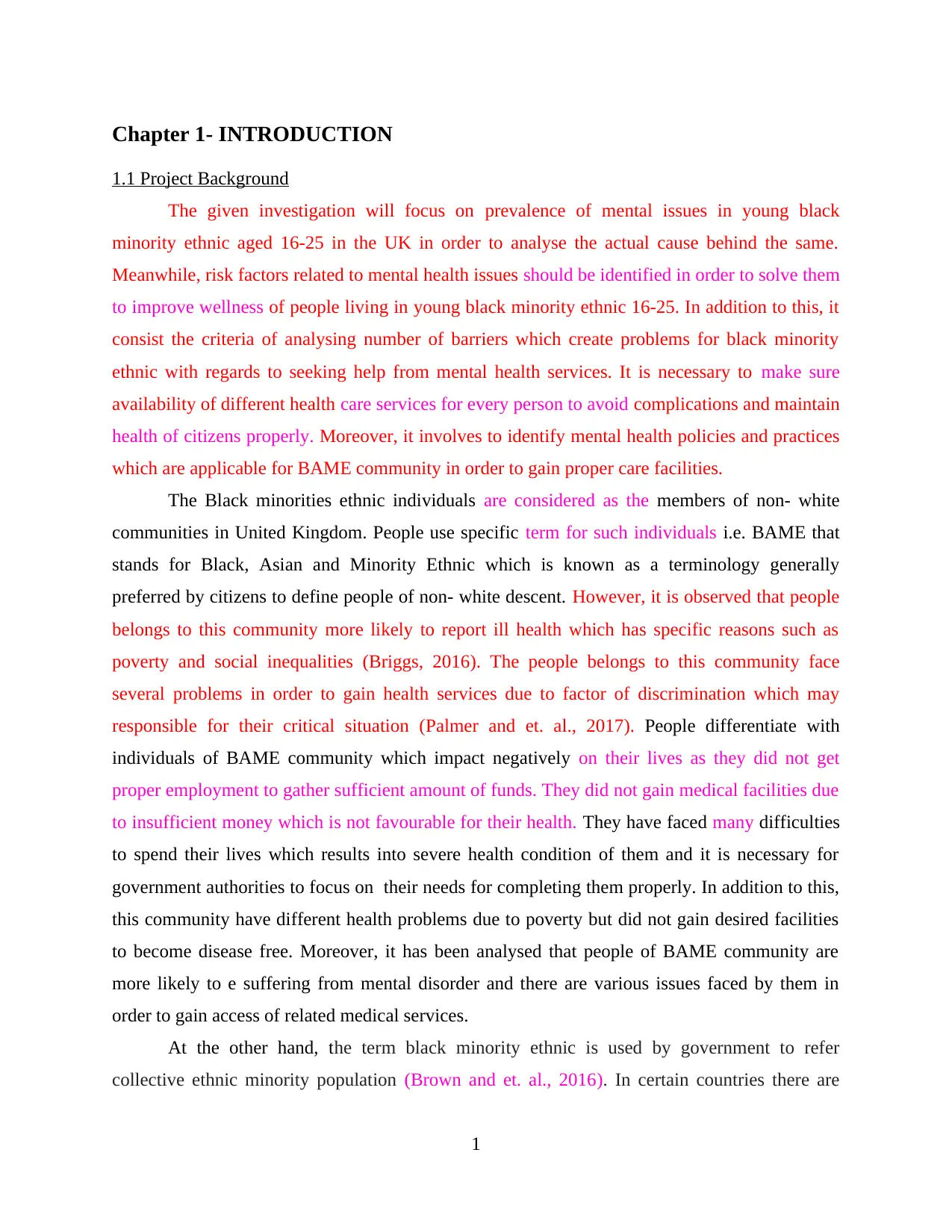
Chapter 1- INTRODUCTION
1.1 Project Background
The given investigation will focus on prevalence of mental issues in young black
minority ethnic aged 16-25 in the UK in order to analyse the actual cause behind the same.
Meanwhile, risk factors related to mental health issues should be identified in order to solve them
to improve wellness of people living in young black minority ethnic 16-25. In addition to this, it
consist the criteria of analysing number of barriers which create problems for black minority
ethnic with regards to seeking help from mental health services. It is necessary to make sure
availability of different health care services for every person to avoid complications and maintain
health of citizens properly. Moreover, it involves to identify mental health policies and practices
which are applicable for BAME community in order to gain proper care facilities.
The Black minorities ethnic individuals are considered as the members of non- white
communities in United Kingdom. People use specific term for such individuals i.e. BAME that
stands for Black, Asian and Minority Ethnic which is known as a terminology generally
preferred by citizens to define people of non- white descent. However, it is observed that people
belongs to this community more likely to report ill health which has specific reasons such as
poverty and social inequalities (Briggs, 2016). The people belongs to this community face
several problems in order to gain health services due to factor of discrimination which may
responsible for their critical situation (Palmer and et. al., 2017). People differentiate with
individuals of BAME community which impact negatively on their lives as they did not get
proper employment to gather sufficient amount of funds. They did not gain medical facilities due
to insufficient money which is not favourable for their health. They have faced many difficulties
to spend their lives which results into severe health condition of them and it is necessary for
government authorities to focus on their needs for completing them properly. In addition to this,
this community have different health problems due to poverty but did not gain desired facilities
to become disease free. Moreover, it has been analysed that people of BAME community are
more likely to e suffering from mental disorder and there are various issues faced by them in
order to gain access of related medical services.
At the other hand, the term black minority ethnic is used by government to refer
collective ethnic minority population (Brown and et. al., 2016). In certain countries there are
1
1.1 Project Background
The given investigation will focus on prevalence of mental issues in young black
minority ethnic aged 16-25 in the UK in order to analyse the actual cause behind the same.
Meanwhile, risk factors related to mental health issues should be identified in order to solve them
to improve wellness of people living in young black minority ethnic 16-25. In addition to this, it
consist the criteria of analysing number of barriers which create problems for black minority
ethnic with regards to seeking help from mental health services. It is necessary to make sure
availability of different health care services for every person to avoid complications and maintain
health of citizens properly. Moreover, it involves to identify mental health policies and practices
which are applicable for BAME community in order to gain proper care facilities.
The Black minorities ethnic individuals are considered as the members of non- white
communities in United Kingdom. People use specific term for such individuals i.e. BAME that
stands for Black, Asian and Minority Ethnic which is known as a terminology generally
preferred by citizens to define people of non- white descent. However, it is observed that people
belongs to this community more likely to report ill health which has specific reasons such as
poverty and social inequalities (Briggs, 2016). The people belongs to this community face
several problems in order to gain health services due to factor of discrimination which may
responsible for their critical situation (Palmer and et. al., 2017). People differentiate with
individuals of BAME community which impact negatively on their lives as they did not get
proper employment to gather sufficient amount of funds. They did not gain medical facilities due
to insufficient money which is not favourable for their health. They have faced many difficulties
to spend their lives which results into severe health condition of them and it is necessary for
government authorities to focus on their needs for completing them properly. In addition to this,
this community have different health problems due to poverty but did not gain desired facilities
to become disease free. Moreover, it has been analysed that people of BAME community are
more likely to e suffering from mental disorder and there are various issues faced by them in
order to gain access of related medical services.
At the other hand, the term black minority ethnic is used by government to refer
collective ethnic minority population (Brown and et. al., 2016). In certain countries there are
1
⊘ This is a preview!⊘
Do you want full access?
Subscribe today to unlock all pages.

Trusted by 1+ million students worldwide
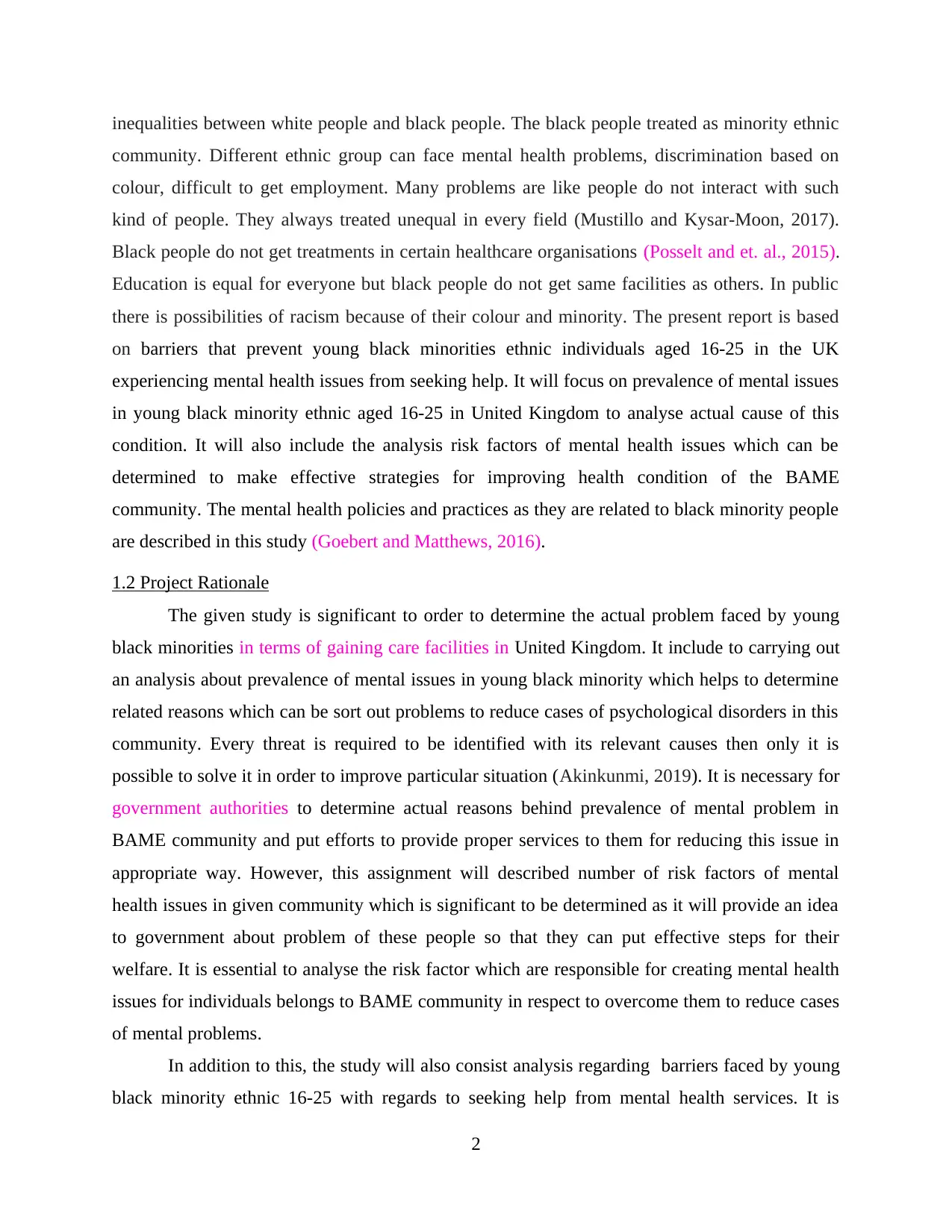
inequalities between white people and black people. The black people treated as minority ethnic
community. Different ethnic group can face mental health problems, discrimination based on
colour, difficult to get employment. Many problems are like people do not interact with such
kind of people. They always treated unequal in every field (Mustillo and Kysar-Moon, 2017).
Black people do not get treatments in certain healthcare organisations (Posselt and et. al., 2015).
Education is equal for everyone but black people do not get same facilities as others. In public
there is possibilities of racism because of their colour and minority. The present report is based
on barriers that prevent young black minorities ethnic individuals aged 16-25 in the UK
experiencing mental health issues from seeking help. It will focus on prevalence of mental issues
in young black minority ethnic aged 16-25 in United Kingdom to analyse actual cause of this
condition. It will also include the analysis risk factors of mental health issues which can be
determined to make effective strategies for improving health condition of the BAME
community. The mental health policies and practices as they are related to black minority people
are described in this study (Goebert and Matthews, 2016).
1.2 Project Rationale
The given study is significant to order to determine the actual problem faced by young
black minorities in terms of gaining care facilities in United Kingdom. It include to carrying out
an analysis about prevalence of mental issues in young black minority which helps to determine
related reasons which can be sort out problems to reduce cases of psychological disorders in this
community. Every threat is required to be identified with its relevant causes then only it is
possible to solve it in order to improve particular situation (Akinkunmi, 2019). It is necessary for
government authorities to determine actual reasons behind prevalence of mental problem in
BAME community and put efforts to provide proper services to them for reducing this issue in
appropriate way. However, this assignment will described number of risk factors of mental
health issues in given community which is significant to be determined as it will provide an idea
to government about problem of these people so that they can put effective steps for their
welfare. It is essential to analyse the risk factor which are responsible for creating mental health
issues for individuals belongs to BAME community in respect to overcome them to reduce cases
of mental problems.
In addition to this, the study will also consist analysis regarding barriers faced by young
black minority ethnic 16-25 with regards to seeking help from mental health services. It is
2
community. Different ethnic group can face mental health problems, discrimination based on
colour, difficult to get employment. Many problems are like people do not interact with such
kind of people. They always treated unequal in every field (Mustillo and Kysar-Moon, 2017).
Black people do not get treatments in certain healthcare organisations (Posselt and et. al., 2015).
Education is equal for everyone but black people do not get same facilities as others. In public
there is possibilities of racism because of their colour and minority. The present report is based
on barriers that prevent young black minorities ethnic individuals aged 16-25 in the UK
experiencing mental health issues from seeking help. It will focus on prevalence of mental issues
in young black minority ethnic aged 16-25 in United Kingdom to analyse actual cause of this
condition. It will also include the analysis risk factors of mental health issues which can be
determined to make effective strategies for improving health condition of the BAME
community. The mental health policies and practices as they are related to black minority people
are described in this study (Goebert and Matthews, 2016).
1.2 Project Rationale
The given study is significant to order to determine the actual problem faced by young
black minorities in terms of gaining care facilities in United Kingdom. It include to carrying out
an analysis about prevalence of mental issues in young black minority which helps to determine
related reasons which can be sort out problems to reduce cases of psychological disorders in this
community. Every threat is required to be identified with its relevant causes then only it is
possible to solve it in order to improve particular situation (Akinkunmi, 2019). It is necessary for
government authorities to determine actual reasons behind prevalence of mental problem in
BAME community and put efforts to provide proper services to them for reducing this issue in
appropriate way. However, this assignment will described number of risk factors of mental
health issues in given community which is significant to be determined as it will provide an idea
to government about problem of these people so that they can put effective steps for their
welfare. It is essential to analyse the risk factor which are responsible for creating mental health
issues for individuals belongs to BAME community in respect to overcome them to reduce cases
of mental problems.
In addition to this, the study will also consist analysis regarding barriers faced by young
black minority ethnic 16-25 with regards to seeking help from mental health services. It is
2
Paraphrase This Document
Need a fresh take? Get an instant paraphrase of this document with our AI Paraphraser
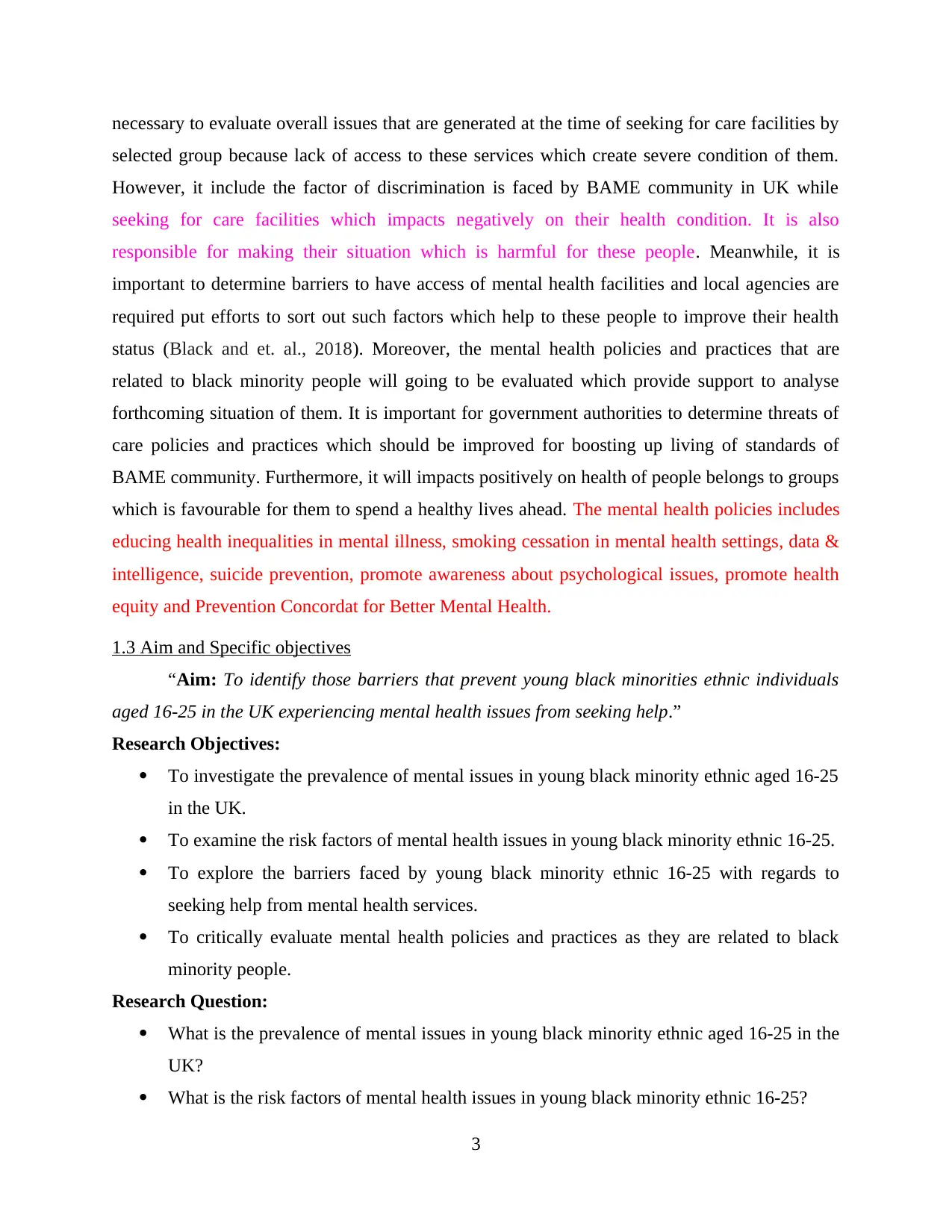
necessary to evaluate overall issues that are generated at the time of seeking for care facilities by
selected group because lack of access to these services which create severe condition of them.
However, it include the factor of discrimination is faced by BAME community in UK while
seeking for care facilities which impacts negatively on their health condition. It is also
responsible for making their situation which is harmful for these people. Meanwhile, it is
important to determine barriers to have access of mental health facilities and local agencies are
required put efforts to sort out such factors which help to these people to improve their health
status (Black and et. al., 2018). Moreover, the mental health policies and practices that are
related to black minority people will going to be evaluated which provide support to analyse
forthcoming situation of them. It is important for government authorities to determine threats of
care policies and practices which should be improved for boosting up living of standards of
BAME community. Furthermore, it will impacts positively on health of people belongs to groups
which is favourable for them to spend a healthy lives ahead. The mental health policies includes
educing health inequalities in mental illness, smoking cessation in mental health settings, data &
intelligence, suicide prevention, promote awareness about psychological issues, promote health
equity and Prevention Concordat for Better Mental Health.
1.3 Aim and Specific objectives
“Aim: To identify those barriers that prevent young black minorities ethnic individuals
aged 16-25 in the UK experiencing mental health issues from seeking help.”
Research Objectives:
To investigate the prevalence of mental issues in young black minority ethnic aged 16-25
in the UK.
To examine the risk factors of mental health issues in young black minority ethnic 16-25.
To explore the barriers faced by young black minority ethnic 16-25 with regards to
seeking help from mental health services.
To critically evaluate mental health policies and practices as they are related to black
minority people.
Research Question:
What is the prevalence of mental issues in young black minority ethnic aged 16-25 in the
UK?
What is the risk factors of mental health issues in young black minority ethnic 16-25?
3
selected group because lack of access to these services which create severe condition of them.
However, it include the factor of discrimination is faced by BAME community in UK while
seeking for care facilities which impacts negatively on their health condition. It is also
responsible for making their situation which is harmful for these people. Meanwhile, it is
important to determine barriers to have access of mental health facilities and local agencies are
required put efforts to sort out such factors which help to these people to improve their health
status (Black and et. al., 2018). Moreover, the mental health policies and practices that are
related to black minority people will going to be evaluated which provide support to analyse
forthcoming situation of them. It is important for government authorities to determine threats of
care policies and practices which should be improved for boosting up living of standards of
BAME community. Furthermore, it will impacts positively on health of people belongs to groups
which is favourable for them to spend a healthy lives ahead. The mental health policies includes
educing health inequalities in mental illness, smoking cessation in mental health settings, data &
intelligence, suicide prevention, promote awareness about psychological issues, promote health
equity and Prevention Concordat for Better Mental Health.
1.3 Aim and Specific objectives
“Aim: To identify those barriers that prevent young black minorities ethnic individuals
aged 16-25 in the UK experiencing mental health issues from seeking help.”
Research Objectives:
To investigate the prevalence of mental issues in young black minority ethnic aged 16-25
in the UK.
To examine the risk factors of mental health issues in young black minority ethnic 16-25.
To explore the barriers faced by young black minority ethnic 16-25 with regards to
seeking help from mental health services.
To critically evaluate mental health policies and practices as they are related to black
minority people.
Research Question:
What is the prevalence of mental issues in young black minority ethnic aged 16-25 in the
UK?
What is the risk factors of mental health issues in young black minority ethnic 16-25?
3
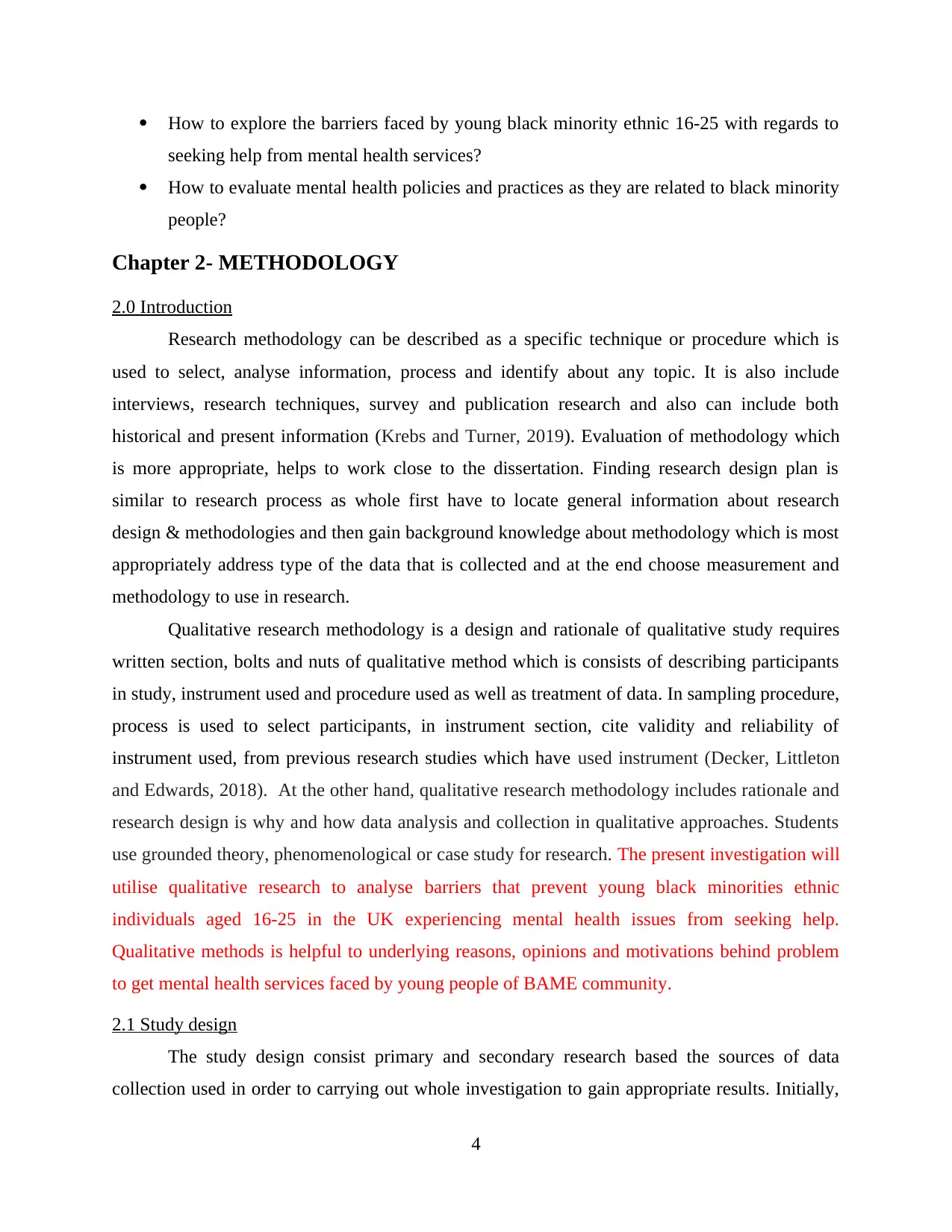
How to explore the barriers faced by young black minority ethnic 16-25 with regards to
seeking help from mental health services?
How to evaluate mental health policies and practices as they are related to black minority
people?
Chapter 2- METHODOLOGY
2.0 Introduction
Research methodology can be described as a specific technique or procedure which is
used to select, analyse information, process and identify about any topic. It is also include
interviews, research techniques, survey and publication research and also can include both
historical and present information (Krebs and Turner, 2019). Evaluation of methodology which
is more appropriate, helps to work close to the dissertation. Finding research design plan is
similar to research process as whole first have to locate general information about research
design & methodologies and then gain background knowledge about methodology which is most
appropriately address type of the data that is collected and at the end choose measurement and
methodology to use in research.
Qualitative research methodology is a design and rationale of qualitative study requires
written section, bolts and nuts of qualitative method which is consists of describing participants
in study, instrument used and procedure used as well as treatment of data. In sampling procedure,
process is used to select participants, in instrument section, cite validity and reliability of
instrument used, from previous research studies which have used instrument (Decker, Littleton
and Edwards, 2018). At the other hand, qualitative research methodology includes rationale and
research design is why and how data analysis and collection in qualitative approaches. Students
use grounded theory, phenomenological or case study for research. The present investigation will
utilise qualitative research to analyse barriers that prevent young black minorities ethnic
individuals aged 16-25 in the UK experiencing mental health issues from seeking help.
Qualitative methods is helpful to underlying reasons, opinions and motivations behind problem
to get mental health services faced by young people of BAME community.
2.1 Study design
The study design consist primary and secondary research based the sources of data
collection used in order to carrying out whole investigation to gain appropriate results. Initially,
4
seeking help from mental health services?
How to evaluate mental health policies and practices as they are related to black minority
people?
Chapter 2- METHODOLOGY
2.0 Introduction
Research methodology can be described as a specific technique or procedure which is
used to select, analyse information, process and identify about any topic. It is also include
interviews, research techniques, survey and publication research and also can include both
historical and present information (Krebs and Turner, 2019). Evaluation of methodology which
is more appropriate, helps to work close to the dissertation. Finding research design plan is
similar to research process as whole first have to locate general information about research
design & methodologies and then gain background knowledge about methodology which is most
appropriately address type of the data that is collected and at the end choose measurement and
methodology to use in research.
Qualitative research methodology is a design and rationale of qualitative study requires
written section, bolts and nuts of qualitative method which is consists of describing participants
in study, instrument used and procedure used as well as treatment of data. In sampling procedure,
process is used to select participants, in instrument section, cite validity and reliability of
instrument used, from previous research studies which have used instrument (Decker, Littleton
and Edwards, 2018). At the other hand, qualitative research methodology includes rationale and
research design is why and how data analysis and collection in qualitative approaches. Students
use grounded theory, phenomenological or case study for research. The present investigation will
utilise qualitative research to analyse barriers that prevent young black minorities ethnic
individuals aged 16-25 in the UK experiencing mental health issues from seeking help.
Qualitative methods is helpful to underlying reasons, opinions and motivations behind problem
to get mental health services faced by young people of BAME community.
2.1 Study design
The study design consist primary and secondary research based the sources of data
collection used in order to carrying out whole investigation to gain appropriate results. Initially,
4
⊘ This is a preview!⊘
Do you want full access?
Subscribe today to unlock all pages.

Trusted by 1+ million students worldwide
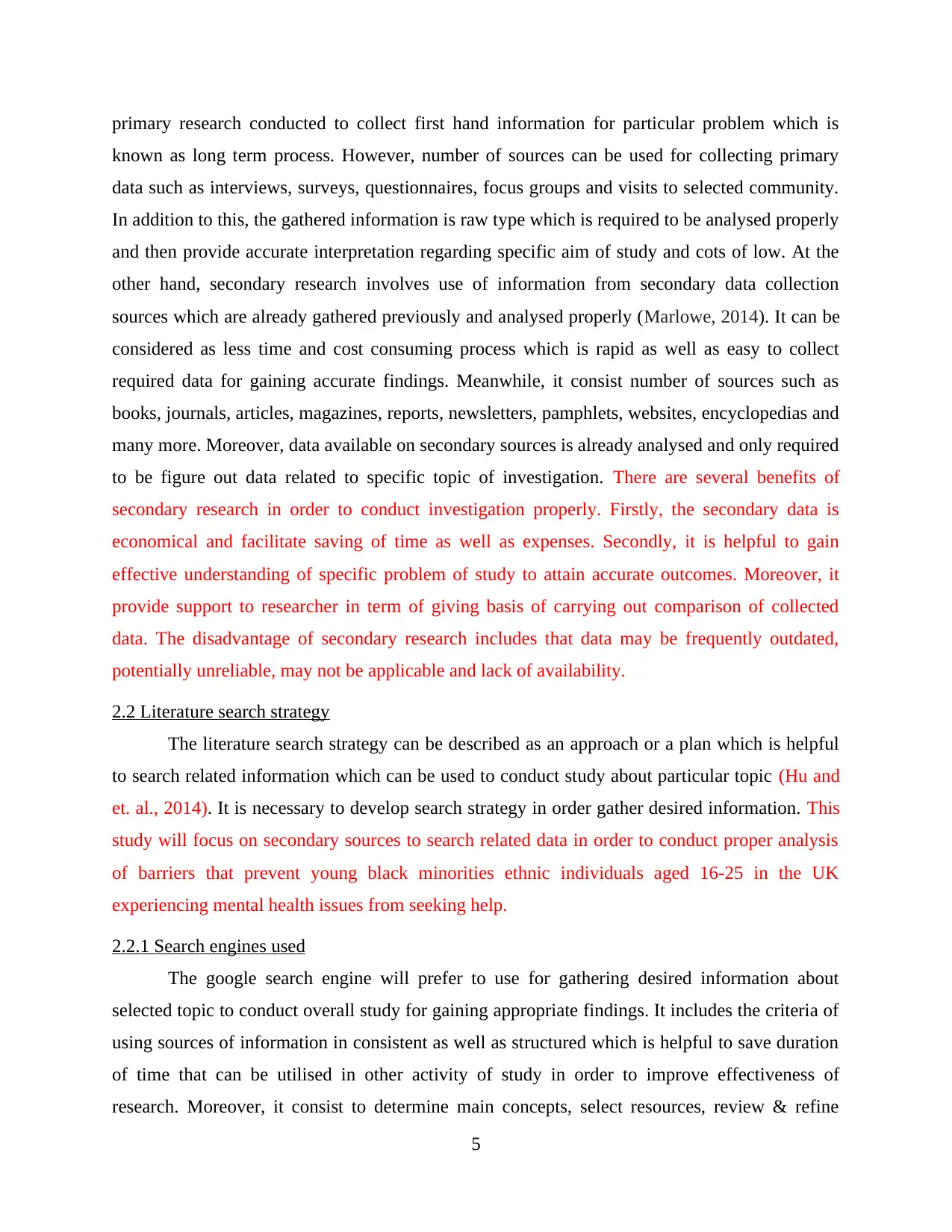
primary research conducted to collect first hand information for particular problem which is
known as long term process. However, number of sources can be used for collecting primary
data such as interviews, surveys, questionnaires, focus groups and visits to selected community.
In addition to this, the gathered information is raw type which is required to be analysed properly
and then provide accurate interpretation regarding specific aim of study and cots of low. At the
other hand, secondary research involves use of information from secondary data collection
sources which are already gathered previously and analysed properly (Marlowe, 2014). It can be
considered as less time and cost consuming process which is rapid as well as easy to collect
required data for gaining accurate findings. Meanwhile, it consist number of sources such as
books, journals, articles, magazines, reports, newsletters, pamphlets, websites, encyclopedias and
many more. Moreover, data available on secondary sources is already analysed and only required
to be figure out data related to specific topic of investigation. There are several benefits of
secondary research in order to conduct investigation properly. Firstly, the secondary data is
economical and facilitate saving of time as well as expenses. Secondly, it is helpful to gain
effective understanding of specific problem of study to attain accurate outcomes. Moreover, it
provide support to researcher in term of giving basis of carrying out comparison of collected
data. The disadvantage of secondary research includes that data may be frequently outdated,
potentially unreliable, may not be applicable and lack of availability.
2.2 Literature search strategy
The literature search strategy can be described as an approach or a plan which is helpful
to search related information which can be used to conduct study about particular topic (Hu and
et. al., 2014). It is necessary to develop search strategy in order gather desired information. This
study will focus on secondary sources to search related data in order to conduct proper analysis
of barriers that prevent young black minorities ethnic individuals aged 16-25 in the UK
experiencing mental health issues from seeking help.
2.2.1 Search engines used
The google search engine will prefer to use for gathering desired information about
selected topic to conduct overall study for gaining appropriate findings. It includes the criteria of
using sources of information in consistent as well as structured which is helpful to save duration
of time that can be utilised in other activity of study in order to improve effectiveness of
research. Moreover, it consist to determine main concepts, select resources, review & refine
5
known as long term process. However, number of sources can be used for collecting primary
data such as interviews, surveys, questionnaires, focus groups and visits to selected community.
In addition to this, the gathered information is raw type which is required to be analysed properly
and then provide accurate interpretation regarding specific aim of study and cots of low. At the
other hand, secondary research involves use of information from secondary data collection
sources which are already gathered previously and analysed properly (Marlowe, 2014). It can be
considered as less time and cost consuming process which is rapid as well as easy to collect
required data for gaining accurate findings. Meanwhile, it consist number of sources such as
books, journals, articles, magazines, reports, newsletters, pamphlets, websites, encyclopedias and
many more. Moreover, data available on secondary sources is already analysed and only required
to be figure out data related to specific topic of investigation. There are several benefits of
secondary research in order to conduct investigation properly. Firstly, the secondary data is
economical and facilitate saving of time as well as expenses. Secondly, it is helpful to gain
effective understanding of specific problem of study to attain accurate outcomes. Moreover, it
provide support to researcher in term of giving basis of carrying out comparison of collected
data. The disadvantage of secondary research includes that data may be frequently outdated,
potentially unreliable, may not be applicable and lack of availability.
2.2 Literature search strategy
The literature search strategy can be described as an approach or a plan which is helpful
to search related information which can be used to conduct study about particular topic (Hu and
et. al., 2014). It is necessary to develop search strategy in order gather desired information. This
study will focus on secondary sources to search related data in order to conduct proper analysis
of barriers that prevent young black minorities ethnic individuals aged 16-25 in the UK
experiencing mental health issues from seeking help.
2.2.1 Search engines used
The google search engine will prefer to use for gathering desired information about
selected topic to conduct overall study for gaining appropriate findings. It includes the criteria of
using sources of information in consistent as well as structured which is helpful to save duration
of time that can be utilised in other activity of study in order to improve effectiveness of
research. Moreover, it consist to determine main concepts, select resources, review & refine
5
Paraphrase This Document
Need a fresh take? Get an instant paraphrase of this document with our AI Paraphraser
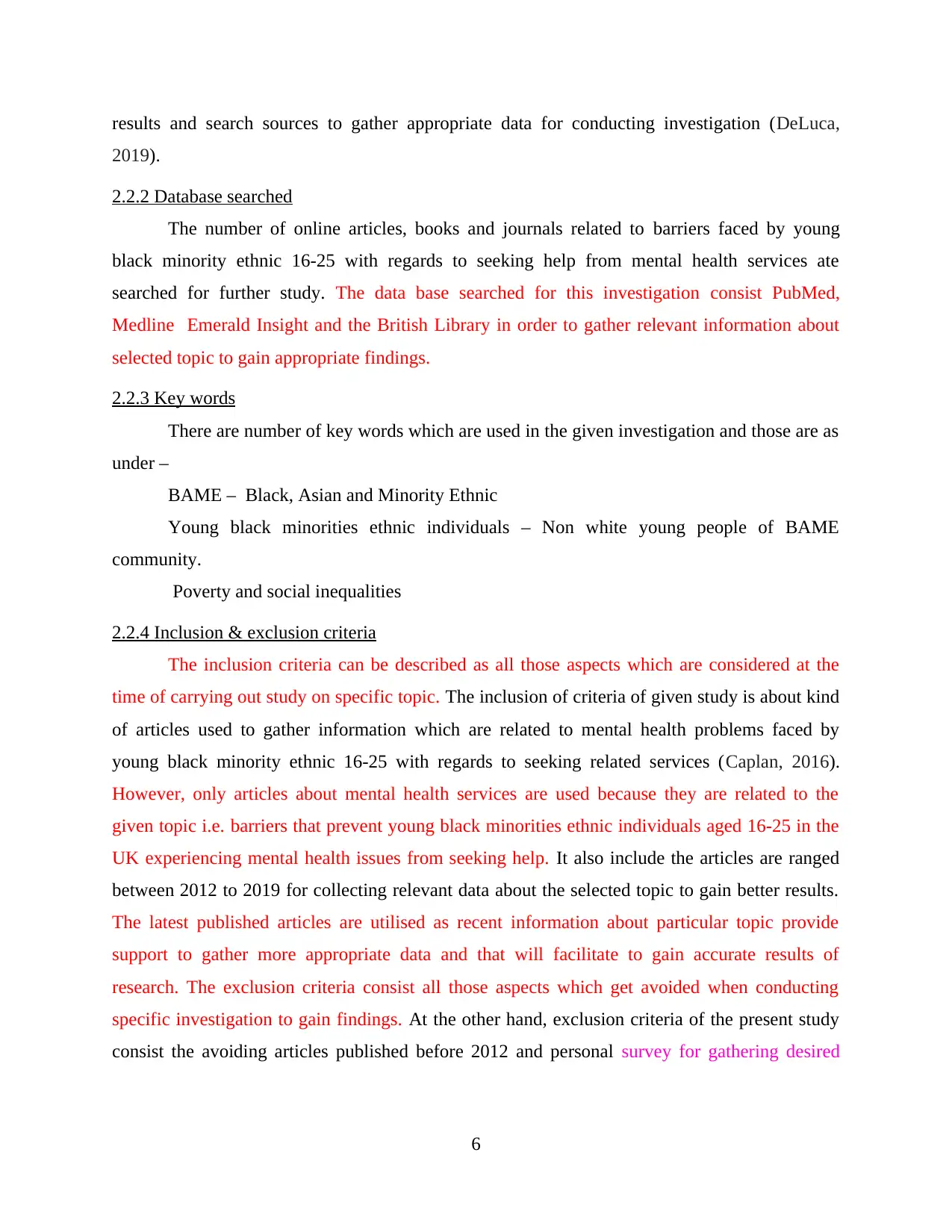
results and search sources to gather appropriate data for conducting investigation (DeLuca,
2019).
2.2.2 Database searched
The number of online articles, books and journals related to barriers faced by young
black minority ethnic 16-25 with regards to seeking help from mental health services ate
searched for further study. The data base searched for this investigation consist PubMed,
Medline Emerald Insight and the British Library in order to gather relevant information about
selected topic to gain appropriate findings.
2.2.3 Key words
There are number of key words which are used in the given investigation and those are as
under –
BAME – Black, Asian and Minority Ethnic
Young black minorities ethnic individuals – Non white young people of BAME
community.
Poverty and social inequalities
2.2.4 Inclusion & exclusion criteria
The inclusion criteria can be described as all those aspects which are considered at the
time of carrying out study on specific topic. The inclusion of criteria of given study is about kind
of articles used to gather information which are related to mental health problems faced by
young black minority ethnic 16-25 with regards to seeking related services (Caplan, 2016).
However, only articles about mental health services are used because they are related to the
given topic i.e. barriers that prevent young black minorities ethnic individuals aged 16-25 in the
UK experiencing mental health issues from seeking help. It also include the articles are ranged
between 2012 to 2019 for collecting relevant data about the selected topic to gain better results.
The latest published articles are utilised as recent information about particular topic provide
support to gather more appropriate data and that will facilitate to gain accurate results of
research. The exclusion criteria consist all those aspects which get avoided when conducting
specific investigation to gain findings. At the other hand, exclusion criteria of the present study
consist the avoiding articles published before 2012 and personal survey for gathering desired
6
2019).
2.2.2 Database searched
The number of online articles, books and journals related to barriers faced by young
black minority ethnic 16-25 with regards to seeking help from mental health services ate
searched for further study. The data base searched for this investigation consist PubMed,
Medline Emerald Insight and the British Library in order to gather relevant information about
selected topic to gain appropriate findings.
2.2.3 Key words
There are number of key words which are used in the given investigation and those are as
under –
BAME – Black, Asian and Minority Ethnic
Young black minorities ethnic individuals – Non white young people of BAME
community.
Poverty and social inequalities
2.2.4 Inclusion & exclusion criteria
The inclusion criteria can be described as all those aspects which are considered at the
time of carrying out study on specific topic. The inclusion of criteria of given study is about kind
of articles used to gather information which are related to mental health problems faced by
young black minority ethnic 16-25 with regards to seeking related services (Caplan, 2016).
However, only articles about mental health services are used because they are related to the
given topic i.e. barriers that prevent young black minorities ethnic individuals aged 16-25 in the
UK experiencing mental health issues from seeking help. It also include the articles are ranged
between 2012 to 2019 for collecting relevant data about the selected topic to gain better results.
The latest published articles are utilised as recent information about particular topic provide
support to gather more appropriate data and that will facilitate to gain accurate results of
research. The exclusion criteria consist all those aspects which get avoided when conducting
specific investigation to gain findings. At the other hand, exclusion criteria of the present study
consist the avoiding articles published before 2012 and personal survey for gathering desired
6
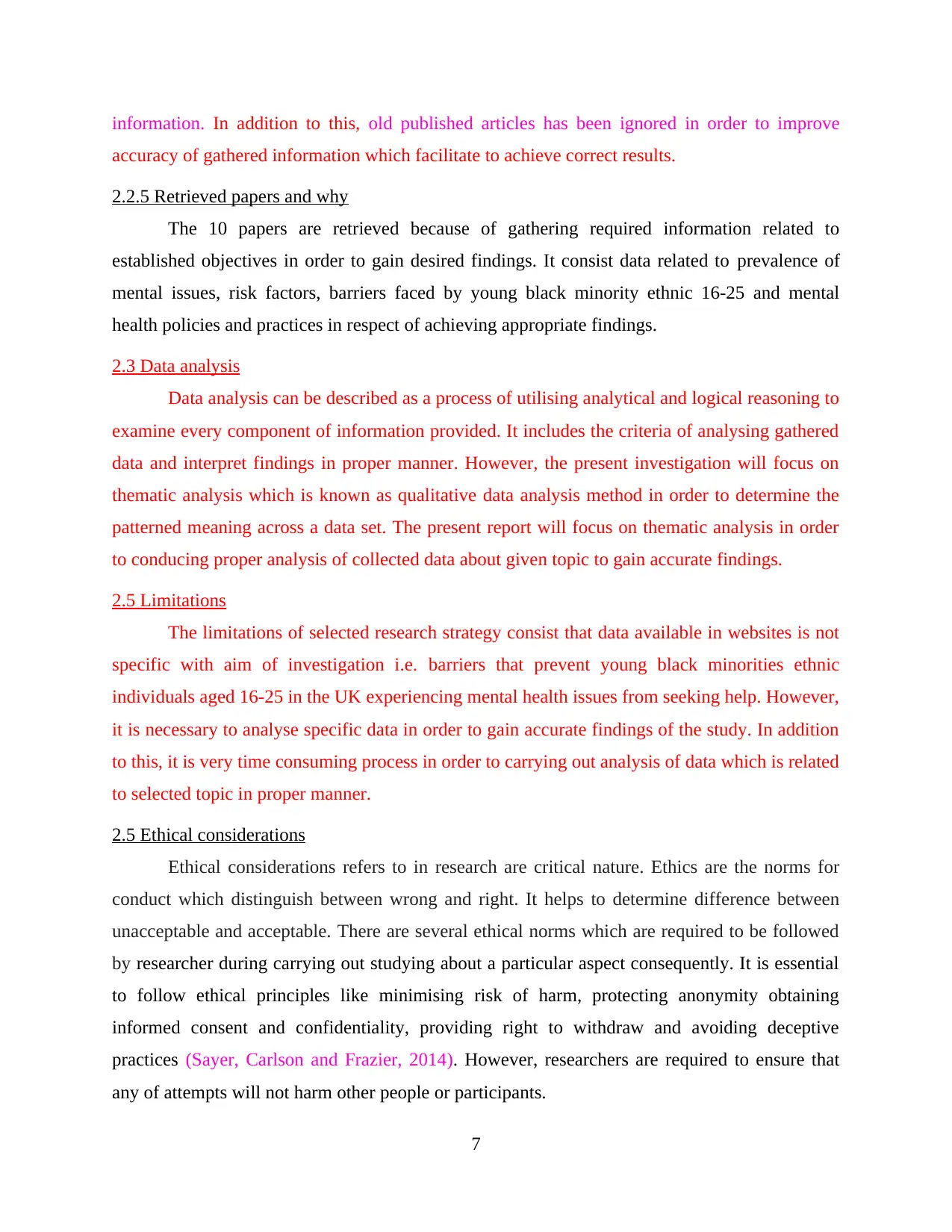
information. In addition to this, old published articles has been ignored in order to improve
accuracy of gathered information which facilitate to achieve correct results.
2.2.5 Retrieved papers and why
The 10 papers are retrieved because of gathering required information related to
established objectives in order to gain desired findings. It consist data related to prevalence of
mental issues, risk factors, barriers faced by young black minority ethnic 16-25 and mental
health policies and practices in respect of achieving appropriate findings.
2.3 Data analysis
Data analysis can be described as a process of utilising analytical and logical reasoning to
examine every component of information provided. It includes the criteria of analysing gathered
data and interpret findings in proper manner. However, the present investigation will focus on
thematic analysis which is known as qualitative data analysis method in order to determine the
patterned meaning across a data set. The present report will focus on thematic analysis in order
to conducing proper analysis of collected data about given topic to gain accurate findings.
2.5 Limitations
The limitations of selected research strategy consist that data available in websites is not
specific with aim of investigation i.e. barriers that prevent young black minorities ethnic
individuals aged 16-25 in the UK experiencing mental health issues from seeking help. However,
it is necessary to analyse specific data in order to gain accurate findings of the study. In addition
to this, it is very time consuming process in order to carrying out analysis of data which is related
to selected topic in proper manner.
2.5 Ethical considerations
Ethical considerations refers to in research are critical nature. Ethics are the norms for
conduct which distinguish between wrong and right. It helps to determine difference between
unacceptable and acceptable. There are several ethical norms which are required to be followed
by researcher during carrying out studying about a particular aspect consequently. It is essential
to follow ethical principles like minimising risk of harm, protecting anonymity obtaining
informed consent and confidentiality, providing right to withdraw and avoiding deceptive
practices (Sayer, Carlson and Frazier, 2014). However, researchers are required to ensure that
any of attempts will not harm other people or participants.
7
accuracy of gathered information which facilitate to achieve correct results.
2.2.5 Retrieved papers and why
The 10 papers are retrieved because of gathering required information related to
established objectives in order to gain desired findings. It consist data related to prevalence of
mental issues, risk factors, barriers faced by young black minority ethnic 16-25 and mental
health policies and practices in respect of achieving appropriate findings.
2.3 Data analysis
Data analysis can be described as a process of utilising analytical and logical reasoning to
examine every component of information provided. It includes the criteria of analysing gathered
data and interpret findings in proper manner. However, the present investigation will focus on
thematic analysis which is known as qualitative data analysis method in order to determine the
patterned meaning across a data set. The present report will focus on thematic analysis in order
to conducing proper analysis of collected data about given topic to gain accurate findings.
2.5 Limitations
The limitations of selected research strategy consist that data available in websites is not
specific with aim of investigation i.e. barriers that prevent young black minorities ethnic
individuals aged 16-25 in the UK experiencing mental health issues from seeking help. However,
it is necessary to analyse specific data in order to gain accurate findings of the study. In addition
to this, it is very time consuming process in order to carrying out analysis of data which is related
to selected topic in proper manner.
2.5 Ethical considerations
Ethical considerations refers to in research are critical nature. Ethics are the norms for
conduct which distinguish between wrong and right. It helps to determine difference between
unacceptable and acceptable. There are several ethical norms which are required to be followed
by researcher during carrying out studying about a particular aspect consequently. It is essential
to follow ethical principles like minimising risk of harm, protecting anonymity obtaining
informed consent and confidentiality, providing right to withdraw and avoiding deceptive
practices (Sayer, Carlson and Frazier, 2014). However, researchers are required to ensure that
any of attempts will not harm other people or participants.
7
⊘ This is a preview!⊘
Do you want full access?
Subscribe today to unlock all pages.

Trusted by 1+ million students worldwide
1 out of 35
Related Documents
Your All-in-One AI-Powered Toolkit for Academic Success.
+13062052269
info@desklib.com
Available 24*7 on WhatsApp / Email
![[object Object]](/_next/static/media/star-bottom.7253800d.svg)
Unlock your academic potential
Copyright © 2020–2025 A2Z Services. All Rights Reserved. Developed and managed by ZUCOL.





